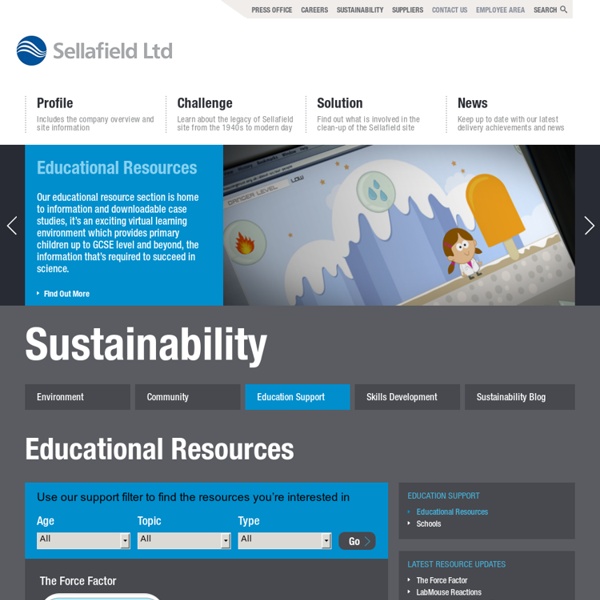



The Field Book Project What is a field book? Field books or field notes are primary source documents that describe the events leading up to and including the collection of specimens or observations during field research. Field notes can take many forms depending on the information needs of the collector. Importance and challenges of field books Field notes are significant sources of information related to scientific discovery. Field books as an object type are located and described in a wide variety of ways.
ARKive - Discover the world's most endangered species Wildscreen's Arkive project was launched in 2003 and grew to become the world's biggest encyclopaedia of life on Earth. With the help of over 7,000 of the world’s best wildlife filmmakers and photographers, conservationists and scientists, Arkive.org featured multi-media fact-files for more than 16,000 endangered species. Freely accessible to everyone, over half a million people every month, from over 200 countries, used Arkive to learn and discover the wonders of the natural world. Since 2013 Wildscreen was unable to raise sufficient funds from trusts, foundations, corporates and individual donors to support the year-round costs of keeping Arkive online. Therefore, the charity had been using its reserves to keep the project online and was unable to fund any dedicated staff to maintain Arkive, let alone future-proof it, for over half a decade. Therefore, a very hard decision was made to take the www.arkive.org website offline in February 2019.
Edheads - Activate Your Mind! Wildlife Filmmaker, Video Mashups, Animal Videos, Wildlife Footage Dispatches Warriors Who Once Feared Elephants Now Protect Them Learn More Animal Facts and Pictures Watch the Webseries Untamed with FILIPE DEANDRADE On TV Mission Critical Latest Stories Weird Animal Question of the Week How do Animals Have Sex Underwater? Weird & Wild This Cockroach May Pollinate Flowers—Extremely Rare Find Wildlife Watch This Turtle Tourist Center Also Raises Endangered Turtles for Meat Magazine A Warming Planet Jolts the Iconic Creatures of the Galápagos Adventure 6 Tips for Better Wildlife Encounters Photo Gallery Best of 2016 20 Photos Best Animal Photos of the Year 2016 Quiz Can You Identify These Animals From Their Close-Ups? Animal Fight Night Dr. Destination Wild
Symphony of Science 50 websites that help make learning science fun Without a doubt my most popular posts have consistently been science websites. Below, I have combined all the science websites that I have shared so far and have added nine new ones. Whether you have been following my blog, or if this is your first time, I promise you will find many great resources for your students. Try Science Try Science is a very cool site that offers many resources to get kids to love science. Quarked This fun website provides a fun way for kids to learn about the subatomic universe. Windows to the Universe Your initial impression is that this is another astronomy website and you would be correct but when you look deeper you will find there is more here than meets the eye. Strange Matter This site is dedicated to helping students learn about material science but in a fun way. Amazing Space This cool website allows students to explore the amazing world of outer space with a wide array of features. Science Kids Science Sparks wants kids of all ages to love science.
125 Great Science Videos: From Astronomy to Physics & Psychology Astronomy & Space Travel A Brief, Wondrous Tour of Earth (From Outer Space) - Video - Recorded from August to October, 2011 at the International Space Station, this HD footage offers a brilliant tour of our planet and stunning views of the aurora borealis.A Universe from Nothing - Video - In 53 minutes, theoretical physicist Lawrence Krauss answers some big enchilada questions, including how the universe came from nothing.A Year of the Moon in 2.5 Minutes - Video - The Lunar Reconnaissance Orbiter has been orbiting the moon for over a year. The footage gets compressed into 2 slick minutes.A Day on Earth (as Seen From Space) - Video - Astronaut Don Pettit trained his camera on planet Earth, took a photo once every 15 seconds, and then created a brilliant time-lapse film.Atlantis's Final Landing at Kennedy Space Center - Video - After more than 30 years, the space shuttle era comes to a close. Physics Biology & Chemistry Environment, Geology and & Ecology Psychology & Neuroscience
Some of The Best Web Tools and Mobile Apps for Taking Students on Virtual Field Trips August 6, 2015 In today’s post we are revisiting some excellent websites and mobile apps you can use with your students to virtually explore some of the most reputed world museums. Most of these platforms include multimedia exhibition guides, maps, visual illustrations and guided tours to help visitors navigate their way around museums. Explore splendid art works and exhibitions right from the comforts of your own couch! Websites to take students into virtual field trips 1-Smithsonian National Museum of Natural History This comprehensive virtual tour allows visitors using a desktop computer (Windows, Mac, Linux) or a mobile device (iPhone, iPad, Android) to take a virtual, self-guided, room-by-room walking tour of the whole museum. 2- Arctic Tour 3- Moon Tour With Moon in Google Earth, you can: Explore the site by selecting an art collection, an artist or an artwork. 5- Planet in Action Google Earth is a highly detailed 3D representation of our entire planet. 6- World Wonders Project